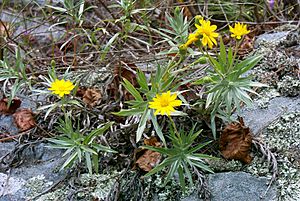Ruth's golden aster facts for kids
Quick facts for kids Ruth's golden aster |
|
|---|---|
 |
|
| Conservation status | |
| Scientific classification | |
| Kingdom: | |
| (unranked): | |
| (unranked): | |
| (unranked): | |
| Order: | |
| Family: | |
| Genus: |
Pityopsis
|
| Species: |
P. ruthii
|
| Binomial name | |
| Pityopsis ruthii Small
|
|
| Synonyms | |
|
Chrysopsis ruthii |
|
Pityopsis ruthii, also known as Ruth's golden aster, is a very rare flowering plant. It belongs to the aster family. This special plant is only found in Polk County, Tennessee, in the United States. It is an endangered species, which means it is in danger of disappearing forever because its home is changing.
About Ruth's Golden Aster
This plant is a small, green plant that grows back every year. It's usually about 10 to 30 centimeters (4 to 12 inches) tall. It grows from a special underground stem called a rhizome. The plant has one or more thin stems covered in shiny, silver hairs. Its leaves at the bottom are shaped like spears and are about 3 or 4 centimeters long. The leaves higher up on the stem are longer and also have silver hairs.
When it blooms, Ruth's golden aster has several flower heads that grow on hairy branches. Each flower head has about nine to eighteen bright yellow petals, called ray florets.
Where It Lives
Ruth's golden aster grows in the cracks of large rocks along two rivers in Tennessee: the Hiwassee River and the Ocoee River. The soil where it grows collects in these rock cracks.
These river rocks often get covered by water when the river levels rise. The strong river water helps to clean the rocks and the soil where the plants grow. This plant needs a lot of sunshine and cannot grow well in shady spots. The flooding and the strong water flow stop other plants from growing too big and blocking the aster's sunlight.
Other plants that grow near Ruth's golden aster include Liatris microcephala (smallhead blazing star), Schizachyrium scoparium (little bluestem), and Andropogon gerardi (big bluestem).
Protecting the Plant
This rare river plant is facing many dangers that affect its home. The parts of the rivers where it lives are located downstream from dams. For example, the Apalachia Dam has changed how the Hiwassee River naturally flows. Water is now taken from the river through pipes to a powerhouse to make electricity. This means less water flows naturally in the river.
When the river flow changes, other plants can start to grow in the small patches of soil where the aster lives. This leads to competition for space and too much shade for the aster. Some of the plants that cause problems include Toxicodendron radicans (poison ivy), Parthenocissus quinquefolia (Virginia creeper), and Lonicera japonica (Japanese honeysuckle). Sometimes, water is released from the dam to wash away harmful pollution that builds up in the river.
When Ruth's golden aster was first listed as an endangered species, its population in the Hiwassee River had dropped by half in just eight years. Since then, it has dropped even more.
The other group of plants on the Ocoee River is also affected by nearby mining activities and power production. This area is also popular for whitewater rafting, which means people walking around can accidentally step on the plants. Even with these threats, the Ocoee population, which has about 593 plants, is currently considered safe.
To help save the plant, scientists are trying to grow it in greenhouses. However, this is hard because the greenhouse plants can get a plant disease called powdery mildew. This mildew is not found on the wild plants.
More and more competing plants are growing each year, which is bad for the aster. The Cherokee National Forest tried to remove poison ivy from the aster's growing spots, and it worked, but it was too difficult to do everywhere. Now, they use other methods, like machines and special chemicals, to remove the unwanted plants.


